Just like other great cuisines like Chinese and French, there's plenty of regional variety in Mexico's food. And just like rice with Chinese and bread with French food, there's a ubiquitous starch tying it all together, in this case tortillas. This meal's menu is an attempt at a sample of regional foods, all while trying to get good variety at the table. From the oven-baked, olivey-sauced huachinango a la veracruzana representing the Caribbean coast's fish and heavy colonial influence, to the annatto-coated and banana-leaf-enrobed cochinita pibil demonstrating the Yucatan's tropical direction, to a beefy salad called salpicón that reflects the livestock and temperature of the North, this meal drew from the many reaches of the country.
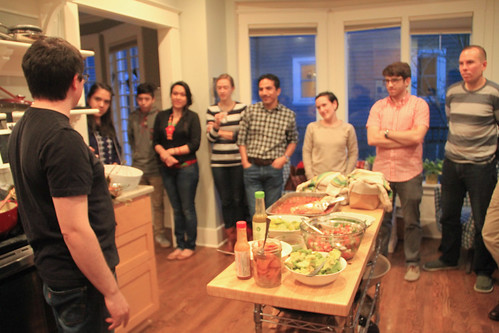
We had a pretty full house, with friends including Alondra, Derek, Jen, Quinn, Katia, Sarah, Estel, Julie, Levi, Kaely, Brett, and Mayra and family.
Tortillas
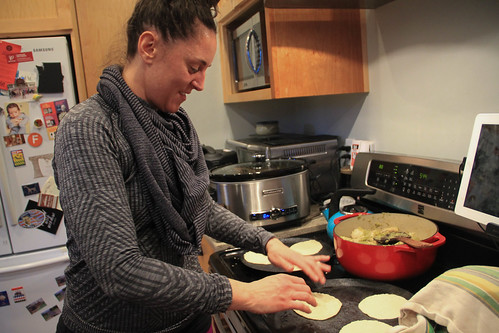
These humble corn flatbreads are a battleground of authenticity, at least in my world. When I pronounce the name with the best Mexican accent I can muster, with a trilled R and a slight affrication on the LL, Laura critiques me for putting on airs. (Don’t even get us started on the pronunciation of bruschetta.) And I’d blithely figured that homemade tortillas would be far more “authentic” than store-bought, until I read this fascinating article making the point that most people in Mexico buy their tortillas out of the house, so in many ways doing the same would best replicate how people eat today.
But, darnit, homemade tortillas just taste better, so we made them. In a nod to practicality and acknowledging the reality of how most tortillas are made in the Mexican kitchen, we used the ubiquitous Maseca flour rather than seeking the more flavorful, rarer, and far more expensive freshly-nixtamalized masa. We got a mini tortilleria going in the kitchen for an hour, passing from mixing to balling to pressing to toasting on the griddle. They were simply delicious.
Salpicón | Shredded beef salad | Recipe
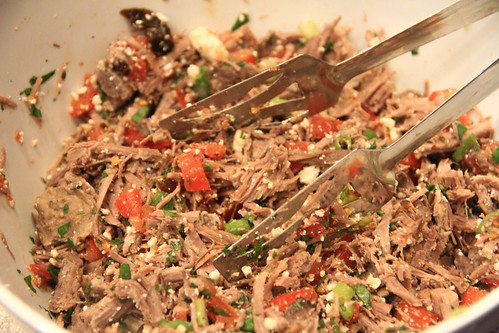
Just as with the Southwest and West Texas across the border, cattle is king in the north of Mexico, so I went about looking for beef recipes from this region. The search ended when I arrived at this dish of cold shredded beef with citrus, onion, scallion, cilantro, and chilies, kind of like a bizarro land-lubber ceviche where the base ingredient is cooked forever rather than not at all. Then again, there was also cheese, so maybe this metaphor falls apart.
Anyway, this was a really yummy dish. If you've got the time, it'd make for a great potluck dish: easy to scale, interesting enough to raise an eyebrow, tasty enough to satisfy, and no need to reheat. What with how hot it is in that part of the world, it being cold is perhaps the best part.
Birria tatemada | Roasted goat | Recipe
Birria comes in two variations. The more common one is as a rich soup, but since this was a meal built to have an abundance of bites on a plate, I went for the roasted version, known as tatemada from a native word related to roasting, one of the treasures of the state of Jalisco. I do not regret the decision.
Usually I decide what dishes to cook for these meals, but sometimes the dishes find me. For the Mauritania meal I had bought and defrosted two goat legs, but it became evident that that was one leg too many, even for a crowd of 15. The day after that meal I got to researching how goat would work into a Mexican meal, and this dish soon showed itself to be the obvious choice.
The overnight marinade is a beautiful blend of worlds: toasted dried chilies and allspice from the New World, and cloves, oregano, and cumin from the old. From there, it's as simple as roasting until the meat is falling apart, perfect for its role as party food.
Mole verde de pollo | Green mole with chicken | Recipe
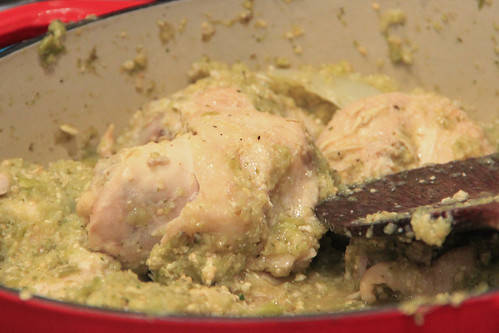
The name comes from either the Spanish moler, to grind, or the native word molcajete for the three-legged stone bowl in which ingredients are traditionally ground. The “seven moles of Oaxaca” are thoroughly codified, and I chose this one for two reasons: to demonstrate how not all moles are made with chocolate, and to represent the tomatillo, an important if lesser-used native vegetable. (Yes, it's actually a fruit, I know that.) In fact, I used the last of these tart green fruits from the collection I froze the prior summer. (Confusingly, the recipe calls for "tomate verde," or green tomato, but rest assured that it's tomatillos you should use.) Pumpkin seeds add some thickness and texture when tossed with the tomatillos in the blender, which is way easier than grinding in the traditional way. Even though I forgot to add the cactus thanks to all the commotion in the kitchen, and the ingredients and technique are fairly simple, this was a tastier dish than I expected. Once this year's tomatillos come in, I very well might make this again.
Cochinita pibil | Annatto-rubbed roast pork | Recipe
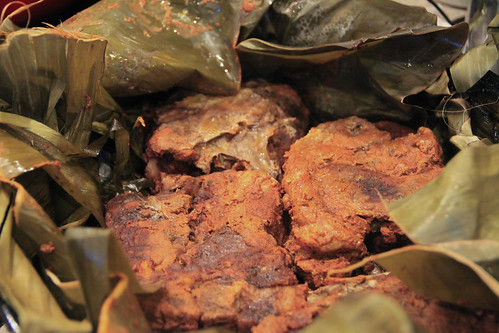
If the Yucatan Peninsula had a national dish, I’m pretty sure this would be it. (A heads-up from a friend though: apparently it’s considered a breakfast food there, so don’t expect to find it for lunch or dinner!)
While traditionally made with a baby pig, hence the name, it’s more common to use a hunk of tougher pig, such as shoulder. A generous coating of a deep red annatto, garlic, and citrus rub penetrates the meat overnight and then through the course of a long, slow roast on the grill, with banana leaves holding in the flavor and generating steam. Both because I’m an overachiever and ran out of cooking space, I did this one on the grill, with lump charcoal and mesquite chunks. The result is irresistible for any carnivore: meat tender enough to pick apart with your fingers, with a tangy flavor that runs all the way through, and of course that smokiness from the grill dancing with a slight musky flavor from the banana leaves. Assuming you’ve got the time to make it — and it’s definitely worth making in the oven if you don’t have the equipment or the will to grill — taco night will never be the same.
Huachinango a la veracruzana | Snapper in tomato sauce | Recipe
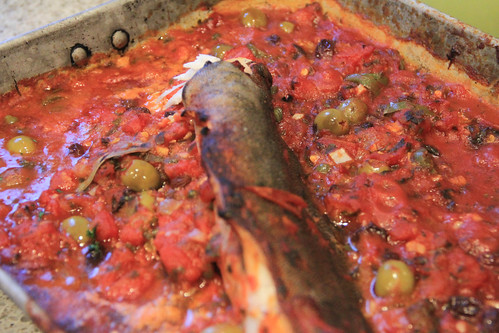
On a group trip to Mexico in high school, we went to a nicer restaurant one night. Orders got mixed up and our dean of students ended up with my order of huachinango a la veracruzana. Upon discovery of the error, Dean Dean (yes, he was Mr. Dean) refused to give me my dish, claiming that he liked it so much he couldn’t stand to give it up.
What dish could cause an authority figure to swindle a student? A baked dish of snapper in a sauce of tomatoes, capers, olives, chilies, and herbs. The Caribbean coast is where the Spanish launched their conquest of what’s now Mexico, leaving a legacy of a local cuisine with a higher degree of European influence, hence several ingredients that are more often seen in the Mediterranean.
Snapper’s both an environmentally iffy choice and wasn’t available when I was looking, and the fishmonger accidentally sold the somewhat similar rockfish I’d ordered, so I ended up with a black cod. What an unexpectedly great substitute this flaky yet soft fish made, melting in the mouth along with that tangy, almost marinara-like sauce.
Arroz a la mexicana | Tomato rice | Recipe
Either this recipe, or my preparation, failed. Perhaps it was the fault of the “sauté then simmer” function of my rice cooker, but it came out pretty flavorless and quite mushy. To be safe, look for another recipe, and make sure to do this one on the stovetop.
Frijoles de la olla | Black beans |Recipe
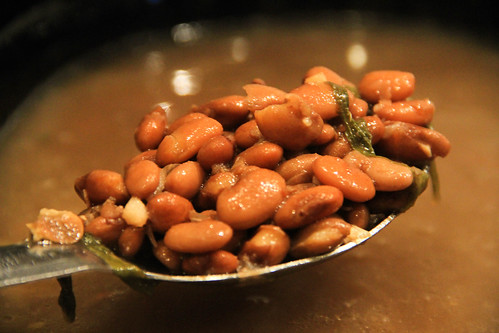
I made these with the classic recipe, and it turned out just right: beans that are tender yet retain their shape, and with enough flavor to stay interesting but not so much that they overpower. If you can find epazote, a sort of razor-toothed herb that’s somewhere between mint and basil with an earthy overtone, it adds a subtle depth and apparently also improves the beans’ digestibility.
Agua de tamarindo | Tamarind drink | Recipe
You’ve likely seen them: those big, pale brown pods, some of which are broken, exposing haphazard strings coated in a darker brown goop. Maybe you’ve even tasted one and recoiled from the tartness. Well, with some hot water and a lot of sugar, you can turn tamarind into a tasty, refreshing drink. Also works great as a mixer for margaritas!
Flan | Custard | Recipe

One of the region’s preferred desserts is torta de tres leches, “three milks cake,” made with a can each of evaporated milk, sweetened condensed milk, and light cream. Another is flan, that cold, jiggly custard with a caramel sauce, just as they enjoy in Spain and France. So what a delight to see that you could make a tres leches flan!
The hardest part of the recipe is making and pouring the caramel, it requires particular attention to avoid burning the sugar or yourself. The second hardest part is setting up a bain marie for even cooking in the oven. Other than that it's as simple as opening cans and blending the contents. The result is a flan that’s thicker and milkier than the traditional custard. It was a hit!